ASB 3009 Strategic Management: Environmental Analysis Frameworks
VerifiedAdded on 2022/08/29
|11
|3437
|13
Report
AI Summary
This report addresses the assignment question of identifying and critically discussing essential analysis frameworks in the external and organizational environments. It begins by emphasizing the importance of environmental analysis for businesses, and introduces frameworks such as PESTLE, which examines political, economic, social, technological, environmental, and legal factors. The report then explores strategy frameworks, including corporate, business, and functional strategies, highlighting their roles in strategic decision-making. It further delves into the SAFe criteria (Suitability, Acceptability, Feasibility), and the VRIO framework (Value, Rarity, Imitability, Organization), which helps in assessing internal capabilities for competitive advantage. Finally, the report discusses Porter’s Five Forces, focusing on the threats of new entrants, substitutes, and competitive rivalry, as well as the bargaining power of buyers and suppliers. The analysis underscores the significance of each framework in facilitating strategic decision-making within the context of the external environment, supporting arguments with academic references.
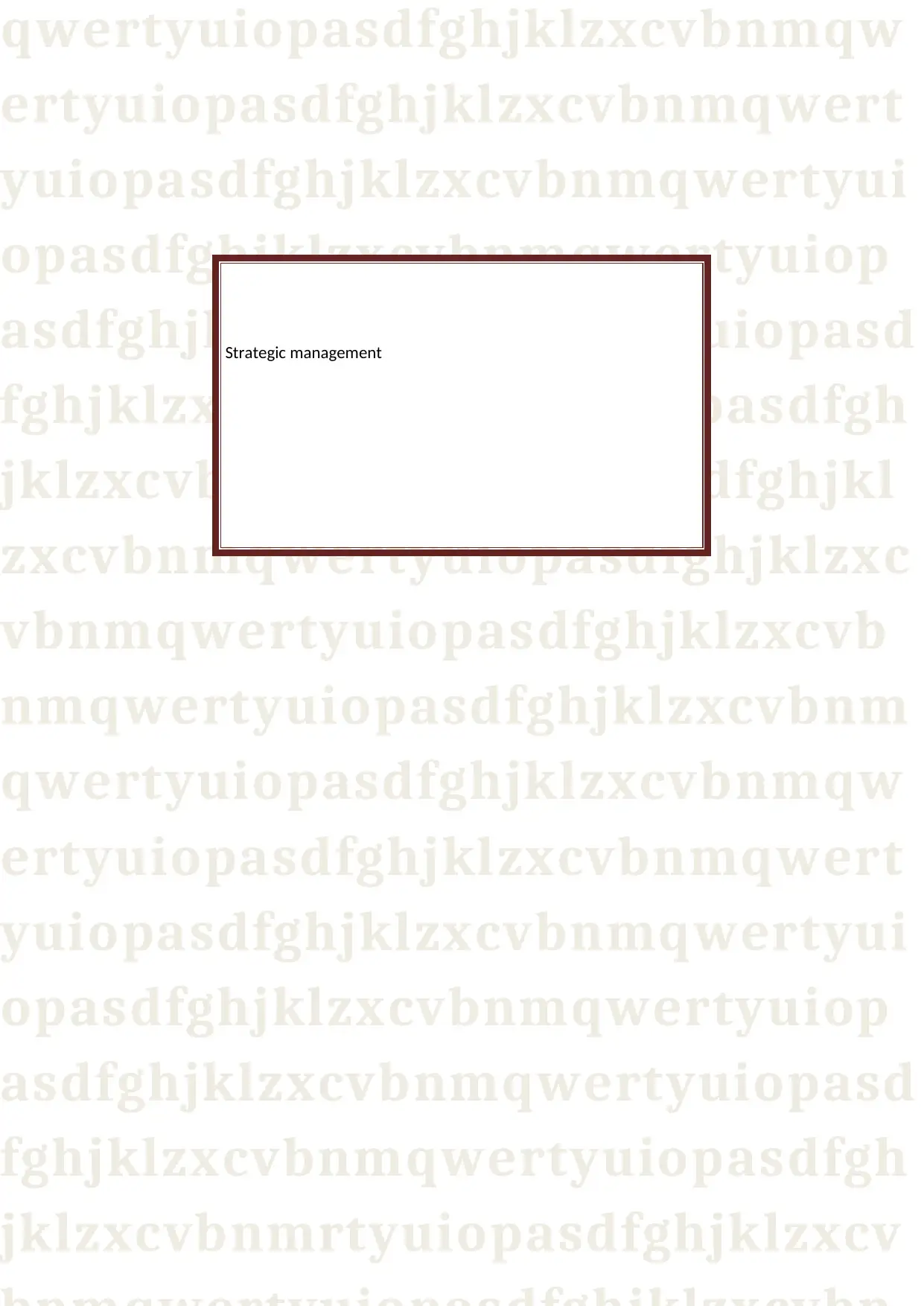
qwertyuiopasdfghjklzxcvbnmqw
ertyuiopasdfghjklzxcvbnmqwert
yuiopasdfghjklzxcvbnmqwertyui
opasdfghjklzxcvbnmqwertyuiop
asdfghjklzxcvbnmqwertyuiopasd
fghjklzxcvbnmqwertyuiopasdfgh
jklzxcvbnmqwertyuiopasdfghjkl
zxcvbnmqwertyuiopasdfghjklzxc
vbnmqwertyuiopasdfghjklzxcvb
nmqwertyuiopasdfghjklzxcvbnm
qwertyuiopasdfghjklzxcvbnmqw
ertyuiopasdfghjklzxcvbnmqwert
yuiopasdfghjklzxcvbnmqwertyui
opasdfghjklzxcvbnmqwertyuiop
asdfghjklzxcvbnmqwertyuiopasd
fghjklzxcvbnmqwertyuiopasdfgh
jklzxcvbnmrtyuiopasdfghjklzxcv
Strategic management
ertyuiopasdfghjklzxcvbnmqwert
yuiopasdfghjklzxcvbnmqwertyui
opasdfghjklzxcvbnmqwertyuiop
asdfghjklzxcvbnmqwertyuiopasd
fghjklzxcvbnmqwertyuiopasdfgh
jklzxcvbnmqwertyuiopasdfghjkl
zxcvbnmqwertyuiopasdfghjklzxc
vbnmqwertyuiopasdfghjklzxcvb
nmqwertyuiopasdfghjklzxcvbnm
qwertyuiopasdfghjklzxcvbnmqw
ertyuiopasdfghjklzxcvbnmqwert
yuiopasdfghjklzxcvbnmqwertyui
opasdfghjklzxcvbnmqwertyuiop
asdfghjklzxcvbnmqwertyuiopasd
fghjklzxcvbnmqwertyuiopasdfgh
jklzxcvbnmrtyuiopasdfghjklzxcv
Strategic management
Paraphrase This Document
Need a fresh take? Get an instant paraphrase of this document with our AI Paraphraser
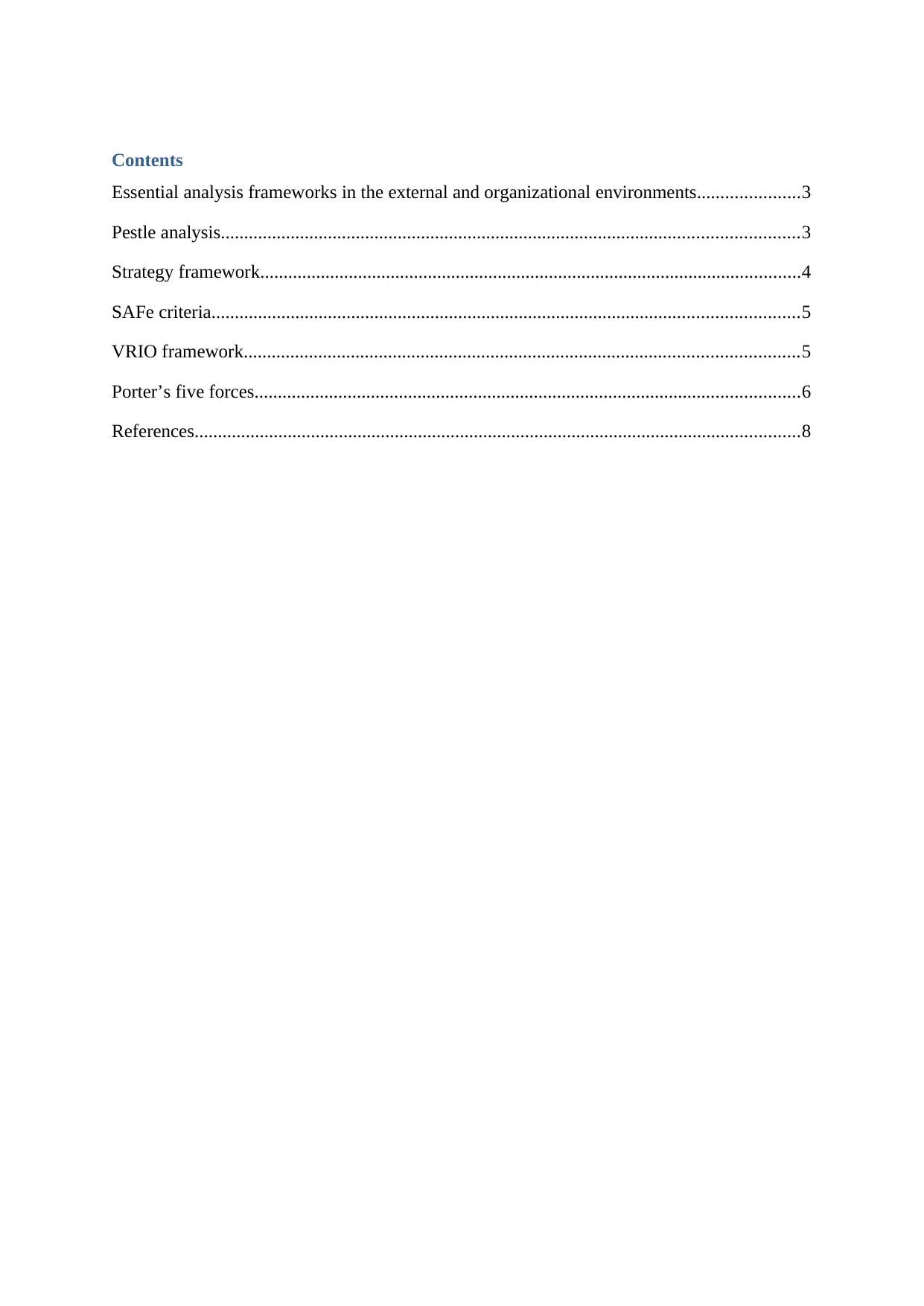
Contents
Essential analysis frameworks in the external and organizational environments......................3
Pestle analysis............................................................................................................................3
Strategy framework....................................................................................................................4
SAFe criteria..............................................................................................................................5
VRIO framework.......................................................................................................................5
Porter’s five forces.....................................................................................................................6
References..................................................................................................................................8
Essential analysis frameworks in the external and organizational environments......................3
Pestle analysis............................................................................................................................3
Strategy framework....................................................................................................................4
SAFe criteria..............................................................................................................................5
VRIO framework.......................................................................................................................5
Porter’s five forces.....................................................................................................................6
References..................................................................................................................................8
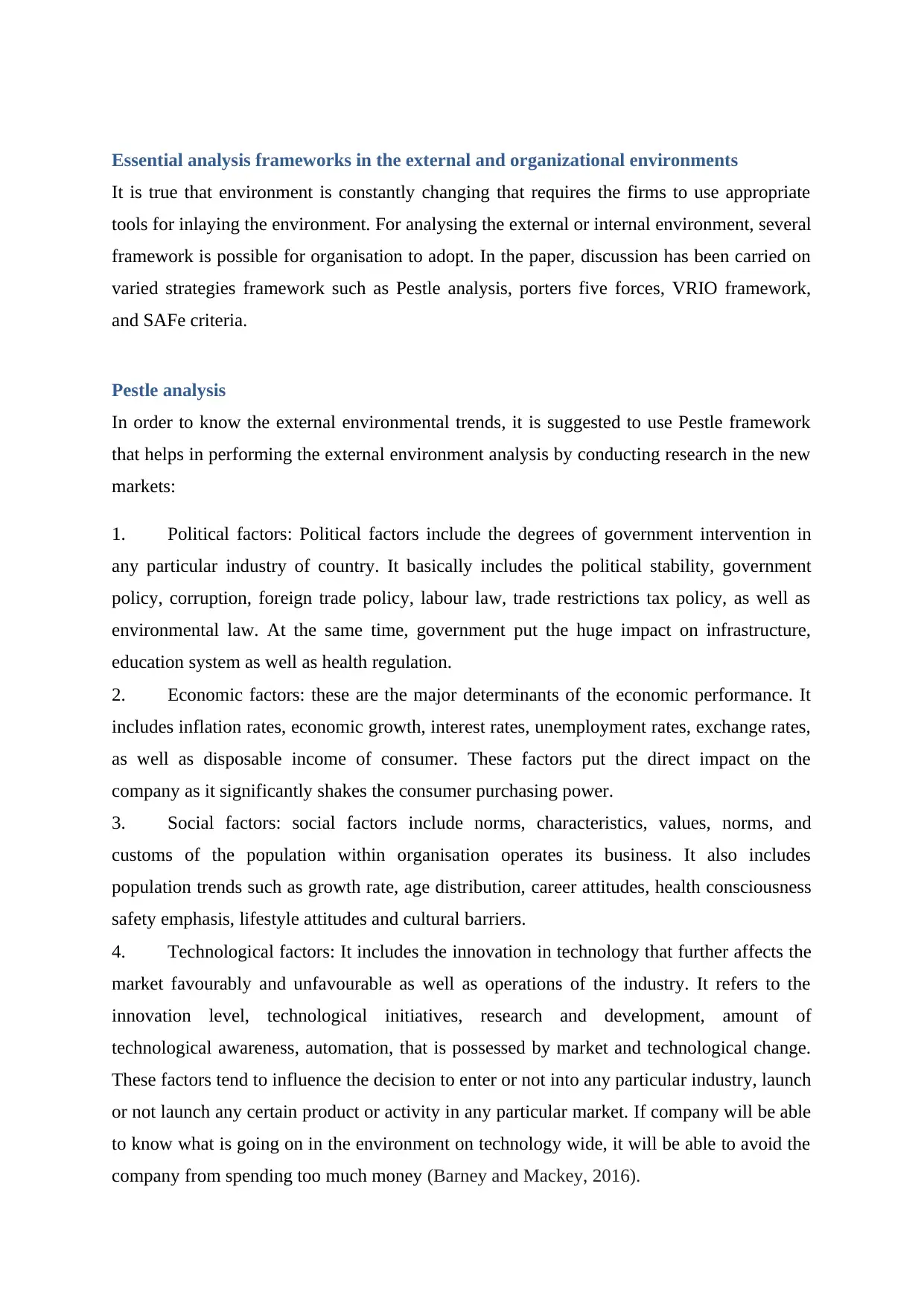
Essential analysis frameworks in the external and organizational environments
It is true that environment is constantly changing that requires the firms to use appropriate
tools for inlaying the environment. For analysing the external or internal environment, several
framework is possible for organisation to adopt. In the paper, discussion has been carried on
varied strategies framework such as Pestle analysis, porters five forces, VRIO framework,
and SAFe criteria.
Pestle analysis
In order to know the external environmental trends, it is suggested to use Pestle framework
that helps in performing the external environment analysis by conducting research in the new
markets:
1. Political factors: Political factors include the degrees of government intervention in
any particular industry of country. It basically includes the political stability, government
policy, corruption, foreign trade policy, labour law, trade restrictions tax policy, as well as
environmental law. At the same time, government put the huge impact on infrastructure,
education system as well as health regulation.
2. Economic factors: these are the major determinants of the economic performance. It
includes inflation rates, economic growth, interest rates, unemployment rates, exchange rates,
as well as disposable income of consumer. These factors put the direct impact on the
company as it significantly shakes the consumer purchasing power.
3. Social factors: social factors include norms, characteristics, values, norms, and
customs of the population within organisation operates its business. It also includes
population trends such as growth rate, age distribution, career attitudes, health consciousness
safety emphasis, lifestyle attitudes and cultural barriers.
4. Technological factors: It includes the innovation in technology that further affects the
market favourably and unfavourable as well as operations of the industry. It refers to the
innovation level, technological initiatives, research and development, amount of
technological awareness, automation, that is possessed by market and technological change.
These factors tend to influence the decision to enter or not into any particular industry, launch
or not launch any certain product or activity in any particular market. If company will be able
to know what is going on in the environment on technology wide, it will be able to avoid the
company from spending too much money (Barney and Mackey, 2016).
It is true that environment is constantly changing that requires the firms to use appropriate
tools for inlaying the environment. For analysing the external or internal environment, several
framework is possible for organisation to adopt. In the paper, discussion has been carried on
varied strategies framework such as Pestle analysis, porters five forces, VRIO framework,
and SAFe criteria.
Pestle analysis
In order to know the external environmental trends, it is suggested to use Pestle framework
that helps in performing the external environment analysis by conducting research in the new
markets:
1. Political factors: Political factors include the degrees of government intervention in
any particular industry of country. It basically includes the political stability, government
policy, corruption, foreign trade policy, labour law, trade restrictions tax policy, as well as
environmental law. At the same time, government put the huge impact on infrastructure,
education system as well as health regulation.
2. Economic factors: these are the major determinants of the economic performance. It
includes inflation rates, economic growth, interest rates, unemployment rates, exchange rates,
as well as disposable income of consumer. These factors put the direct impact on the
company as it significantly shakes the consumer purchasing power.
3. Social factors: social factors include norms, characteristics, values, norms, and
customs of the population within organisation operates its business. It also includes
population trends such as growth rate, age distribution, career attitudes, health consciousness
safety emphasis, lifestyle attitudes and cultural barriers.
4. Technological factors: It includes the innovation in technology that further affects the
market favourably and unfavourable as well as operations of the industry. It refers to the
innovation level, technological initiatives, research and development, amount of
technological awareness, automation, that is possessed by market and technological change.
These factors tend to influence the decision to enter or not into any particular industry, launch
or not launch any certain product or activity in any particular market. If company will be able
to know what is going on in the environment on technology wide, it will be able to avoid the
company from spending too much money (Barney and Mackey, 2016).
⊘ This is a preview!⊘
Do you want full access?
Subscribe today to unlock all pages.

Trusted by 1+ million students worldwide

5. Environmental factors: These factors are important due to the increasing raw material
scarcity, carbon footprint target, as well as pollution target set by the government. These
factors tend to include the ecological as well as environmental aspects such as weather,
climate, climate change as well as environmental targets that significantly affects industries
such as insurance, tourism, farming, and agriculture. In the recent time, companies are
required to give emphasis on environmental measures as it significantly affect the
organisational internal activities as well as it operations (Tosun and Peters, 2018).
6. Legal factors: These factors include the specific laws such as discrimination laws,
antitrust laws, consumer protection laws, employment laws, patent laws, copyright laws as
well as safety and health laws. In order to ensure the successful business operation in any
country, companies are required to significantly follow the laws made by the government of
that country related to the industry in which companies operates. In this way, it is clear what
is legal and what is not permitted in order to do trade successfully. It any organisation do
trade globally, it is quite tricky to follow rules and laws to get the right as every country has
their own set of regulations and rules (Narayanan and Adams, 2017).
Strategy framework
Organisational environment is required to be assess with the help of “exploring strategy
framework” that helps in making the strategic choices for the future (Gutierrez, Boukrami
and Lumsden, 2015). It includes three value strategy. Corporate level strategy gives emphasis
on the entire scope of the organisation by knowing how it is adding value to the different
business units. Corporate strategy is long-term strategy that provides direction to the business
(Issa, Chang and Issa, 2010). However, it might not prove to be successful as today’s
competitive business environment requires different changes time-to-time when any
government policy or customer demand changes. Business strategy on the other hand is
directly concerned with the way a business successfully compete in any particular market.
Business strategy includes the corporate goals, challenges, or success of the current strategy
as well as market condition such as market innovations, changing customer preferences as
well as regulatory shifts (Singh, 2020). Business strategy creates challenges when a quick
shift in the market condition is seen or any market innovation brought by the outside
environmental pressures (Benson, 2020). Due to this, it is required by company to ensure
proper research and development. Functional strategy is directly concerned with how the
varied parts of organisation tend to deliver the strategy properly in terms of managing
scarcity, carbon footprint target, as well as pollution target set by the government. These
factors tend to include the ecological as well as environmental aspects such as weather,
climate, climate change as well as environmental targets that significantly affects industries
such as insurance, tourism, farming, and agriculture. In the recent time, companies are
required to give emphasis on environmental measures as it significantly affect the
organisational internal activities as well as it operations (Tosun and Peters, 2018).
6. Legal factors: These factors include the specific laws such as discrimination laws,
antitrust laws, consumer protection laws, employment laws, patent laws, copyright laws as
well as safety and health laws. In order to ensure the successful business operation in any
country, companies are required to significantly follow the laws made by the government of
that country related to the industry in which companies operates. In this way, it is clear what
is legal and what is not permitted in order to do trade successfully. It any organisation do
trade globally, it is quite tricky to follow rules and laws to get the right as every country has
their own set of regulations and rules (Narayanan and Adams, 2017).
Strategy framework
Organisational environment is required to be assess with the help of “exploring strategy
framework” that helps in making the strategic choices for the future (Gutierrez, Boukrami
and Lumsden, 2015). It includes three value strategy. Corporate level strategy gives emphasis
on the entire scope of the organisation by knowing how it is adding value to the different
business units. Corporate strategy is long-term strategy that provides direction to the business
(Issa, Chang and Issa, 2010). However, it might not prove to be successful as today’s
competitive business environment requires different changes time-to-time when any
government policy or customer demand changes. Business strategy on the other hand is
directly concerned with the way a business successfully compete in any particular market.
Business strategy includes the corporate goals, challenges, or success of the current strategy
as well as market condition such as market innovations, changing customer preferences as
well as regulatory shifts (Singh, 2020). Business strategy creates challenges when a quick
shift in the market condition is seen or any market innovation brought by the outside
environmental pressures (Benson, 2020). Due to this, it is required by company to ensure
proper research and development. Functional strategy is directly concerned with how the
varied parts of organisation tend to deliver the strategy properly in terms of managing
Paraphrase This Document
Need a fresh take? Get an instant paraphrase of this document with our AI Paraphraser
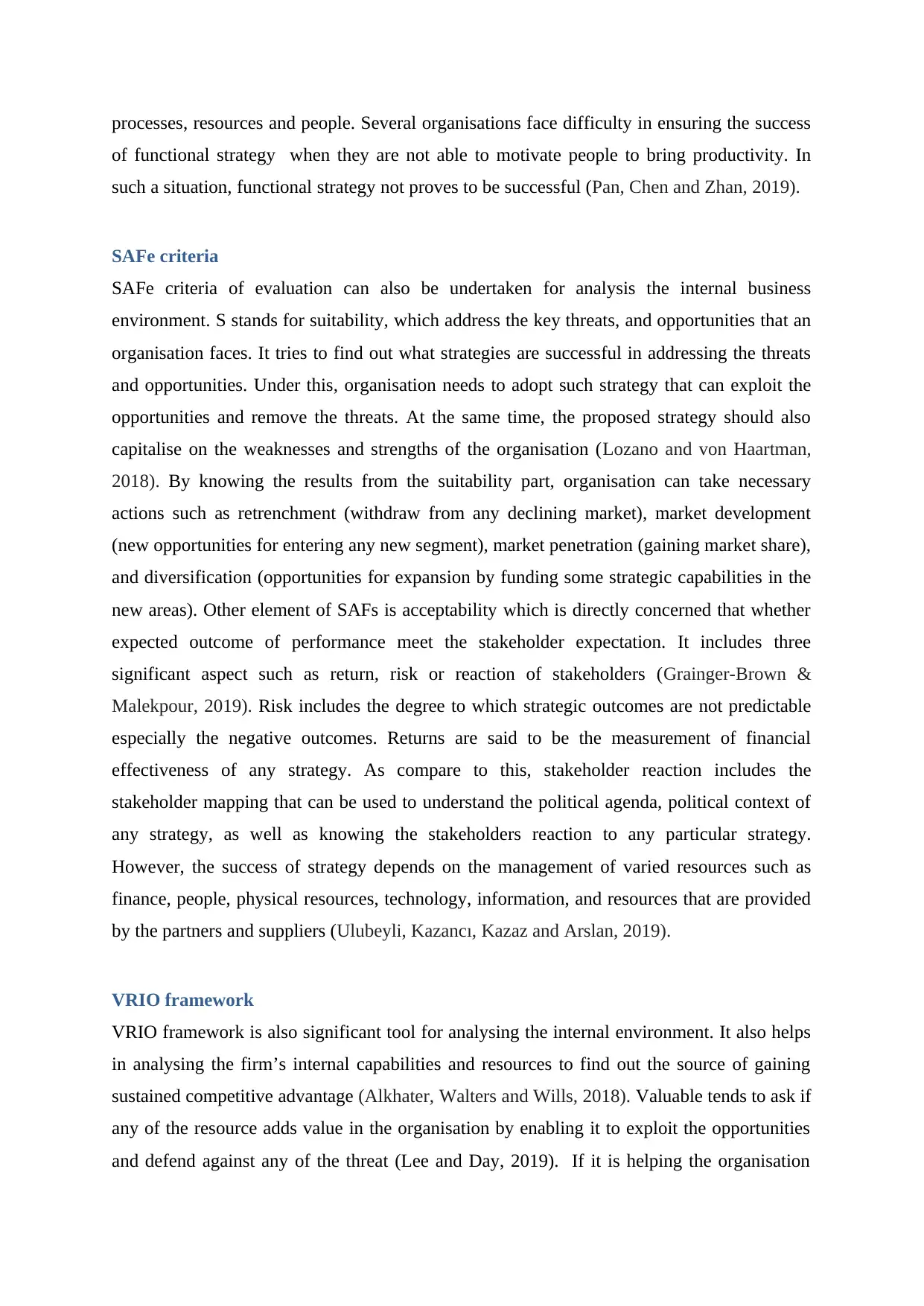
processes, resources and people. Several organisations face difficulty in ensuring the success
of functional strategy when they are not able to motivate people to bring productivity. In
such a situation, functional strategy not proves to be successful (Pan, Chen and Zhan, 2019).
SAFe criteria
SAFe criteria of evaluation can also be undertaken for analysis the internal business
environment. S stands for suitability, which address the key threats, and opportunities that an
organisation faces. It tries to find out what strategies are successful in addressing the threats
and opportunities. Under this, organisation needs to adopt such strategy that can exploit the
opportunities and remove the threats. At the same time, the proposed strategy should also
capitalise on the weaknesses and strengths of the organisation (Lozano and von Haartman,
2018). By knowing the results from the suitability part, organisation can take necessary
actions such as retrenchment (withdraw from any declining market), market development
(new opportunities for entering any new segment), market penetration (gaining market share),
and diversification (opportunities for expansion by funding some strategic capabilities in the
new areas). Other element of SAFs is acceptability which is directly concerned that whether
expected outcome of performance meet the stakeholder expectation. It includes three
significant aspect such as return, risk or reaction of stakeholders (Grainger-Brown &
Malekpour, 2019). Risk includes the degree to which strategic outcomes are not predictable
especially the negative outcomes. Returns are said to be the measurement of financial
effectiveness of any strategy. As compare to this, stakeholder reaction includes the
stakeholder mapping that can be used to understand the political agenda, political context of
any strategy, as well as knowing the stakeholders reaction to any particular strategy.
However, the success of strategy depends on the management of varied resources such as
finance, people, physical resources, technology, information, and resources that are provided
by the partners and suppliers (Ulubeyli, Kazancı, Kazaz and Arslan, 2019).
VRIO framework
VRIO framework is also significant tool for analysing the internal environment. It also helps
in analysing the firm’s internal capabilities and resources to find out the source of gaining
sustained competitive advantage (Alkhater, Walters and Wills, 2018). Valuable tends to ask if
any of the resource adds value in the organisation by enabling it to exploit the opportunities
and defend against any of the threat (Lee and Day, 2019). If it is helping the organisation
of functional strategy when they are not able to motivate people to bring productivity. In
such a situation, functional strategy not proves to be successful (Pan, Chen and Zhan, 2019).
SAFe criteria
SAFe criteria of evaluation can also be undertaken for analysis the internal business
environment. S stands for suitability, which address the key threats, and opportunities that an
organisation faces. It tries to find out what strategies are successful in addressing the threats
and opportunities. Under this, organisation needs to adopt such strategy that can exploit the
opportunities and remove the threats. At the same time, the proposed strategy should also
capitalise on the weaknesses and strengths of the organisation (Lozano and von Haartman,
2018). By knowing the results from the suitability part, organisation can take necessary
actions such as retrenchment (withdraw from any declining market), market development
(new opportunities for entering any new segment), market penetration (gaining market share),
and diversification (opportunities for expansion by funding some strategic capabilities in the
new areas). Other element of SAFs is acceptability which is directly concerned that whether
expected outcome of performance meet the stakeholder expectation. It includes three
significant aspect such as return, risk or reaction of stakeholders (Grainger-Brown &
Malekpour, 2019). Risk includes the degree to which strategic outcomes are not predictable
especially the negative outcomes. Returns are said to be the measurement of financial
effectiveness of any strategy. As compare to this, stakeholder reaction includes the
stakeholder mapping that can be used to understand the political agenda, political context of
any strategy, as well as knowing the stakeholders reaction to any particular strategy.
However, the success of strategy depends on the management of varied resources such as
finance, people, physical resources, technology, information, and resources that are provided
by the partners and suppliers (Ulubeyli, Kazancı, Kazaz and Arslan, 2019).
VRIO framework
VRIO framework is also significant tool for analysing the internal environment. It also helps
in analysing the firm’s internal capabilities and resources to find out the source of gaining
sustained competitive advantage (Alkhater, Walters and Wills, 2018). Valuable tends to ask if
any of the resource adds value in the organisation by enabling it to exploit the opportunities
and defend against any of the threat (Lee and Day, 2019). If it is helping the organisation
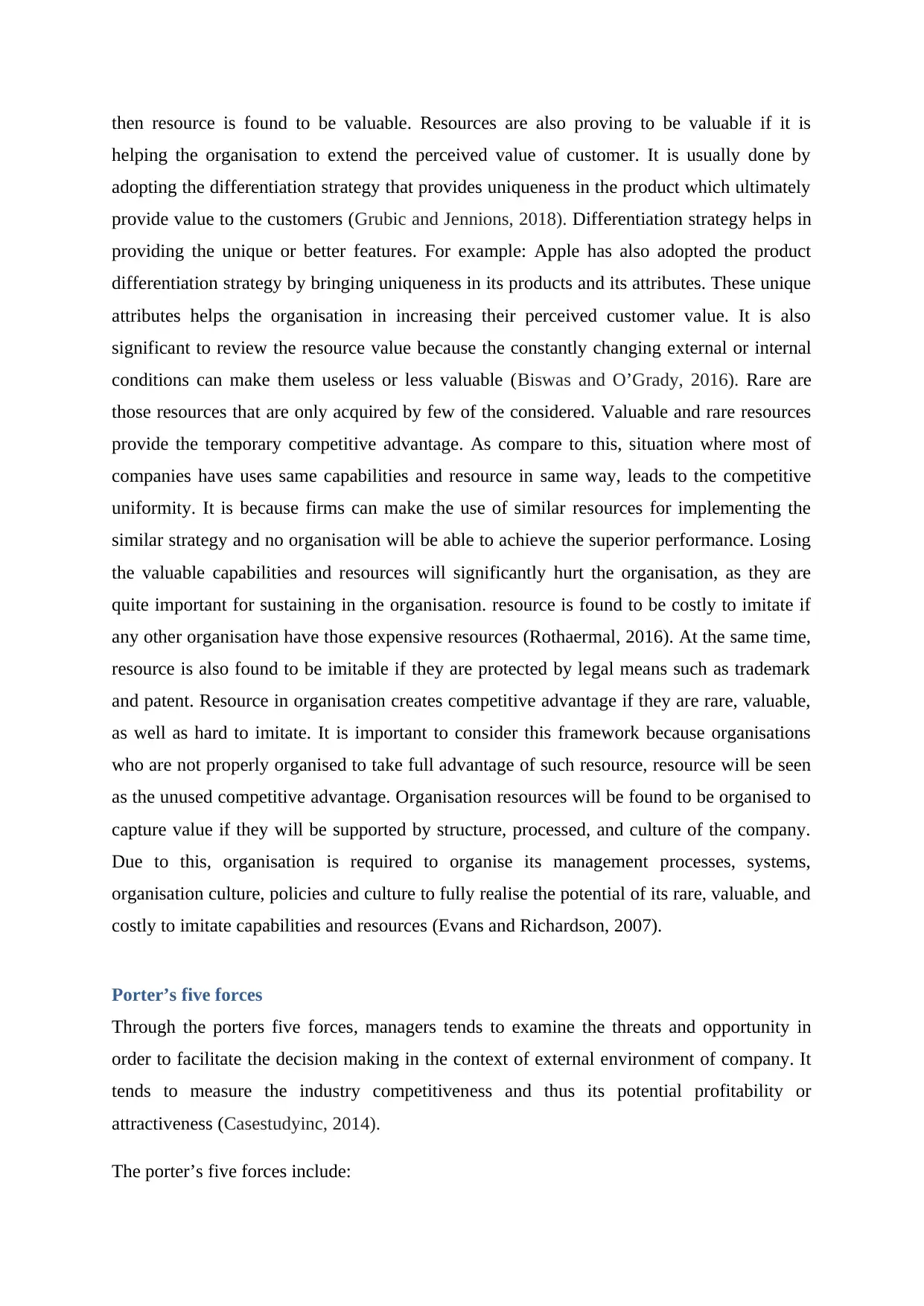
then resource is found to be valuable. Resources are also proving to be valuable if it is
helping the organisation to extend the perceived value of customer. It is usually done by
adopting the differentiation strategy that provides uniqueness in the product which ultimately
provide value to the customers (Grubic and Jennions, 2018). Differentiation strategy helps in
providing the unique or better features. For example: Apple has also adopted the product
differentiation strategy by bringing uniqueness in its products and its attributes. These unique
attributes helps the organisation in increasing their perceived customer value. It is also
significant to review the resource value because the constantly changing external or internal
conditions can make them useless or less valuable (Biswas and O’Grady, 2016). Rare are
those resources that are only acquired by few of the considered. Valuable and rare resources
provide the temporary competitive advantage. As compare to this, situation where most of
companies have uses same capabilities and resource in same way, leads to the competitive
uniformity. It is because firms can make the use of similar resources for implementing the
similar strategy and no organisation will be able to achieve the superior performance. Losing
the valuable capabilities and resources will significantly hurt the organisation, as they are
quite important for sustaining in the organisation. resource is found to be costly to imitate if
any other organisation have those expensive resources (Rothaermal, 2016). At the same time,
resource is also found to be imitable if they are protected by legal means such as trademark
and patent. Resource in organisation creates competitive advantage if they are rare, valuable,
as well as hard to imitate. It is important to consider this framework because organisations
who are not properly organised to take full advantage of such resource, resource will be seen
as the unused competitive advantage. Organisation resources will be found to be organised to
capture value if they will be supported by structure, processed, and culture of the company.
Due to this, organisation is required to organise its management processes, systems,
organisation culture, policies and culture to fully realise the potential of its rare, valuable, and
costly to imitate capabilities and resources (Evans and Richardson, 2007).
Porter’s five forces
Through the porters five forces, managers tends to examine the threats and opportunity in
order to facilitate the decision making in the context of external environment of company. It
tends to measure the industry competitiveness and thus its potential profitability or
attractiveness (Casestudyinc, 2014).
The porter’s five forces include:
helping the organisation to extend the perceived value of customer. It is usually done by
adopting the differentiation strategy that provides uniqueness in the product which ultimately
provide value to the customers (Grubic and Jennions, 2018). Differentiation strategy helps in
providing the unique or better features. For example: Apple has also adopted the product
differentiation strategy by bringing uniqueness in its products and its attributes. These unique
attributes helps the organisation in increasing their perceived customer value. It is also
significant to review the resource value because the constantly changing external or internal
conditions can make them useless or less valuable (Biswas and O’Grady, 2016). Rare are
those resources that are only acquired by few of the considered. Valuable and rare resources
provide the temporary competitive advantage. As compare to this, situation where most of
companies have uses same capabilities and resource in same way, leads to the competitive
uniformity. It is because firms can make the use of similar resources for implementing the
similar strategy and no organisation will be able to achieve the superior performance. Losing
the valuable capabilities and resources will significantly hurt the organisation, as they are
quite important for sustaining in the organisation. resource is found to be costly to imitate if
any other organisation have those expensive resources (Rothaermal, 2016). At the same time,
resource is also found to be imitable if they are protected by legal means such as trademark
and patent. Resource in organisation creates competitive advantage if they are rare, valuable,
as well as hard to imitate. It is important to consider this framework because organisations
who are not properly organised to take full advantage of such resource, resource will be seen
as the unused competitive advantage. Organisation resources will be found to be organised to
capture value if they will be supported by structure, processed, and culture of the company.
Due to this, organisation is required to organise its management processes, systems,
organisation culture, policies and culture to fully realise the potential of its rare, valuable, and
costly to imitate capabilities and resources (Evans and Richardson, 2007).
Porter’s five forces
Through the porters five forces, managers tends to examine the threats and opportunity in
order to facilitate the decision making in the context of external environment of company. It
tends to measure the industry competitiveness and thus its potential profitability or
attractiveness (Casestudyinc, 2014).
The porter’s five forces include:
⊘ This is a preview!⊘
Do you want full access?
Subscribe today to unlock all pages.

Trusted by 1+ million students worldwide

Threat of entrant: It refers to the threat of new entrants tends to pose to the current
business in the industry (Rosli, 2016). A profitable industry always attracts the new
competitors. There might be the higher threat of entrant when any company brand is not
known, when it is quite easy for customers to switch to any new supplier or when any
copyright or trademark is not involve in the production process. For example: it is not easy
for any industry to enter in airline because it requires too much investment to pay for
personnel, equipment, and airport gateways (Porter, 2008).
Threat of substitute service and product: substitute product is not similar to the
competitor but a different service or product altogether. For example: email might be the
substitute for writing letter, or team might be the substitute for the coffee (Acquier, Valiorgue
& Daudigeos, 2017).
Competitive rivalry within the industry: Porter believes that the level or intensity of
the competition in the industry is one of the major force that tends to determine the
profitability in any of the industry. Intensity of the competitor is also affected by the size of
market, competitors number, growth of industry, as well as how it is difficult to bring
difference in any product. Automotive and airline industry is the example of high rivalry
industry (Indartono and Wibowo, 2017).
Bargaining power of buyer: it is said to be amount of pressure that customer put on
the seller. Buyer always wants to buy the products in low price, better quality, and increasing
service. From the seller’s point of view, industry where the buyer has higher bargaining
power is not found to be attractive because competitors might have many strategies for taking
the customers easily away (Dobbs, 2014). High bargaining buying power decreases if seller
directly response to the tactics of buyers. For example: company such as Walmart has lot of
bargaining power of buyer due to the high volume of the purchase (Mukherjee, 2018).
Bargaining power of suppliers: t is another force that tends to shape the competitive
measure of the industry as it limits the seller capability to make the profit. It is true that
powerful supplier tends to put pressure on the byer by lowering quality, increasing prices as
well as decreasing the supply availability.
business in the industry (Rosli, 2016). A profitable industry always attracts the new
competitors. There might be the higher threat of entrant when any company brand is not
known, when it is quite easy for customers to switch to any new supplier or when any
copyright or trademark is not involve in the production process. For example: it is not easy
for any industry to enter in airline because it requires too much investment to pay for
personnel, equipment, and airport gateways (Porter, 2008).
Threat of substitute service and product: substitute product is not similar to the
competitor but a different service or product altogether. For example: email might be the
substitute for writing letter, or team might be the substitute for the coffee (Acquier, Valiorgue
& Daudigeos, 2017).
Competitive rivalry within the industry: Porter believes that the level or intensity of
the competition in the industry is one of the major force that tends to determine the
profitability in any of the industry. Intensity of the competitor is also affected by the size of
market, competitors number, growth of industry, as well as how it is difficult to bring
difference in any product. Automotive and airline industry is the example of high rivalry
industry (Indartono and Wibowo, 2017).
Bargaining power of buyer: it is said to be amount of pressure that customer put on
the seller. Buyer always wants to buy the products in low price, better quality, and increasing
service. From the seller’s point of view, industry where the buyer has higher bargaining
power is not found to be attractive because competitors might have many strategies for taking
the customers easily away (Dobbs, 2014). High bargaining buying power decreases if seller
directly response to the tactics of buyers. For example: company such as Walmart has lot of
bargaining power of buyer due to the high volume of the purchase (Mukherjee, 2018).
Bargaining power of suppliers: t is another force that tends to shape the competitive
measure of the industry as it limits the seller capability to make the profit. It is true that
powerful supplier tends to put pressure on the byer by lowering quality, increasing prices as
well as decreasing the supply availability.
Paraphrase This Document
Need a fresh take? Get an instant paraphrase of this document with our AI Paraphraser
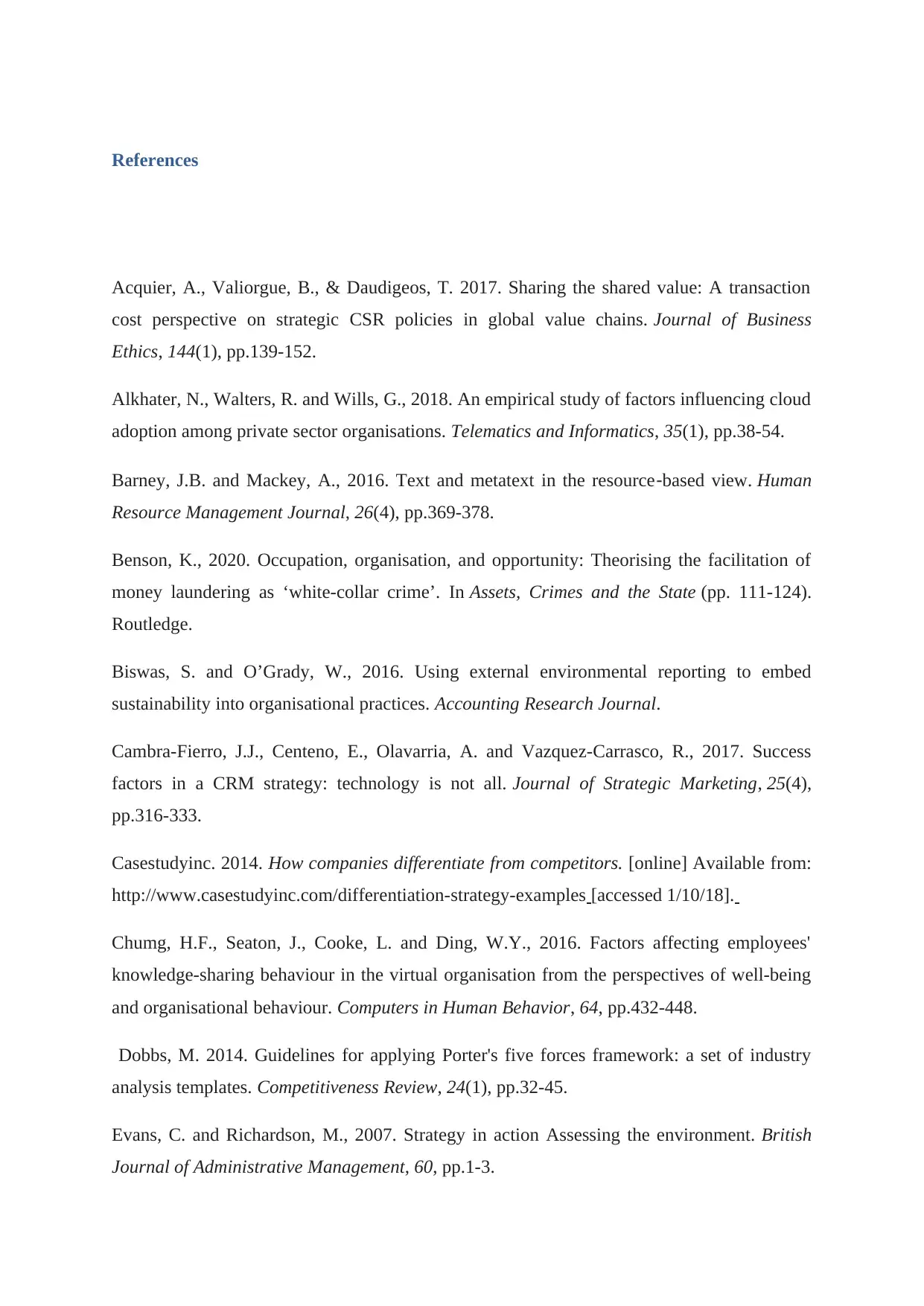
References
Acquier, A., Valiorgue, B., & Daudigeos, T. 2017. Sharing the shared value: A transaction
cost perspective on strategic CSR policies in global value chains. Journal of Business
Ethics, 144(1), pp.139-152.
Alkhater, N., Walters, R. and Wills, G., 2018. An empirical study of factors influencing cloud
adoption among private sector organisations. Telematics and Informatics, 35(1), pp.38-54.
Barney, J.B. and Mackey, A., 2016. Text and metatext in the resource‐based view. Human
Resource Management Journal, 26(4), pp.369-378.
Benson, K., 2020. Occupation, organisation, and opportunity: Theorising the facilitation of
money laundering as ‘white-collar crime’. In Assets, Crimes and the State (pp. 111-124).
Routledge.
Biswas, S. and O’Grady, W., 2016. Using external environmental reporting to embed
sustainability into organisational practices. Accounting Research Journal.
Cambra-Fierro, J.J., Centeno, E., Olavarria, A. and Vazquez-Carrasco, R., 2017. Success
factors in a CRM strategy: technology is not all. Journal of Strategic Marketing, 25(4),
pp.316-333.
Casestudyinc. 2014. How companies differentiate from competitors. [online] Available from:
http://www.casestudyinc.com/differentiation-strategy-examples [accessed 1/10/18].
Chumg, H.F., Seaton, J., Cooke, L. and Ding, W.Y., 2016. Factors affecting employees'
knowledge-sharing behaviour in the virtual organisation from the perspectives of well-being
and organisational behaviour. Computers in Human Behavior, 64, pp.432-448.
Dobbs, M. 2014. Guidelines for applying Porter's five forces framework: a set of industry
analysis templates. Competitiveness Review, 24(1), pp.32-45.
Evans, C. and Richardson, M., 2007. Strategy in action Assessing the environment. British
Journal of Administrative Management, 60, pp.1-3.
Acquier, A., Valiorgue, B., & Daudigeos, T. 2017. Sharing the shared value: A transaction
cost perspective on strategic CSR policies in global value chains. Journal of Business
Ethics, 144(1), pp.139-152.
Alkhater, N., Walters, R. and Wills, G., 2018. An empirical study of factors influencing cloud
adoption among private sector organisations. Telematics and Informatics, 35(1), pp.38-54.
Barney, J.B. and Mackey, A., 2016. Text and metatext in the resource‐based view. Human
Resource Management Journal, 26(4), pp.369-378.
Benson, K., 2020. Occupation, organisation, and opportunity: Theorising the facilitation of
money laundering as ‘white-collar crime’. In Assets, Crimes and the State (pp. 111-124).
Routledge.
Biswas, S. and O’Grady, W., 2016. Using external environmental reporting to embed
sustainability into organisational practices. Accounting Research Journal.
Cambra-Fierro, J.J., Centeno, E., Olavarria, A. and Vazquez-Carrasco, R., 2017. Success
factors in a CRM strategy: technology is not all. Journal of Strategic Marketing, 25(4),
pp.316-333.
Casestudyinc. 2014. How companies differentiate from competitors. [online] Available from:
http://www.casestudyinc.com/differentiation-strategy-examples [accessed 1/10/18].
Chumg, H.F., Seaton, J., Cooke, L. and Ding, W.Y., 2016. Factors affecting employees'
knowledge-sharing behaviour in the virtual organisation from the perspectives of well-being
and organisational behaviour. Computers in Human Behavior, 64, pp.432-448.
Dobbs, M. 2014. Guidelines for applying Porter's five forces framework: a set of industry
analysis templates. Competitiveness Review, 24(1), pp.32-45.
Evans, C. and Richardson, M., 2007. Strategy in action Assessing the environment. British
Journal of Administrative Management, 60, pp.1-3.
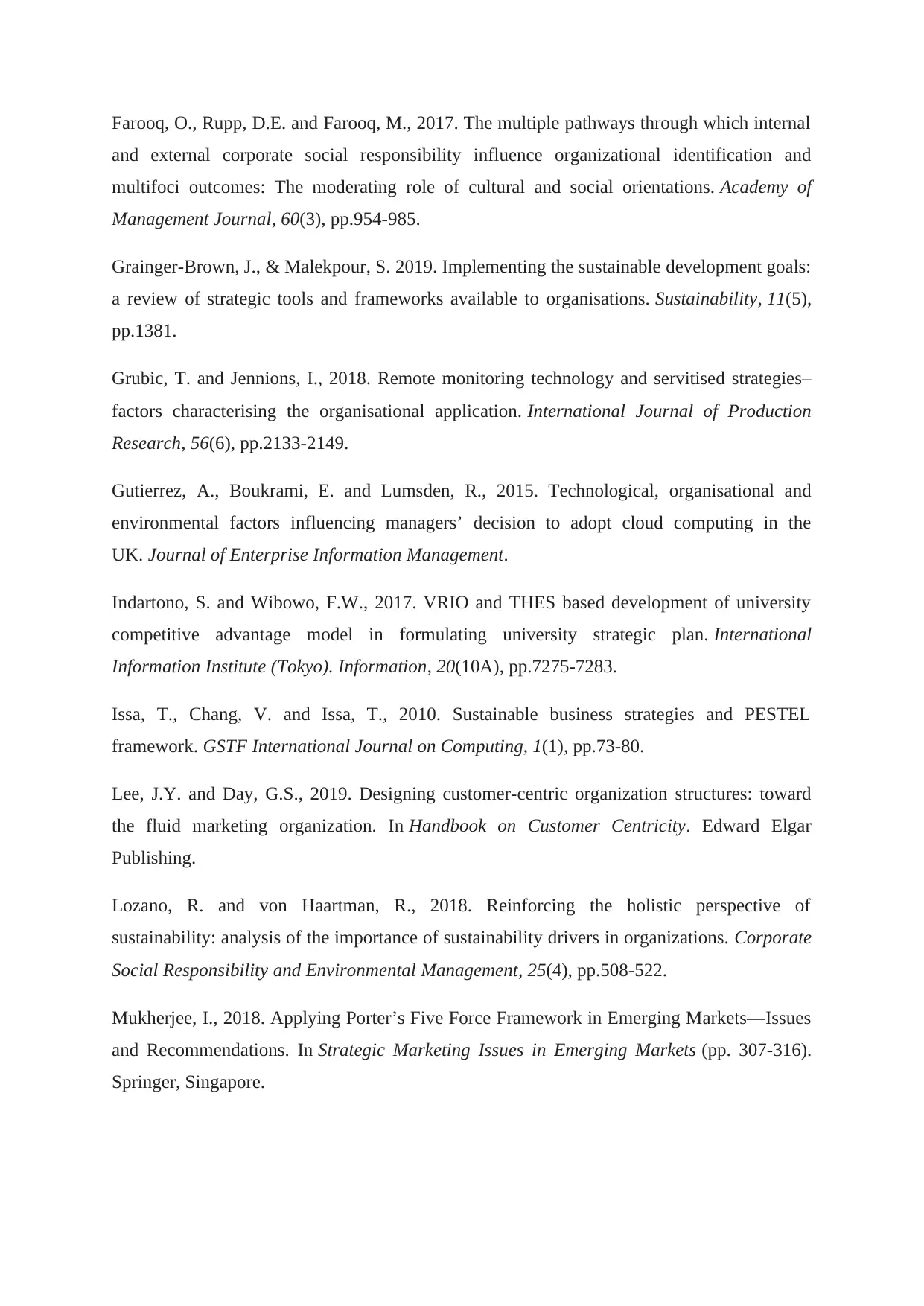
Farooq, O., Rupp, D.E. and Farooq, M., 2017. The multiple pathways through which internal
and external corporate social responsibility influence organizational identification and
multifoci outcomes: The moderating role of cultural and social orientations. Academy of
Management Journal, 60(3), pp.954-985.
Grainger-Brown, J., & Malekpour, S. 2019. Implementing the sustainable development goals:
a review of strategic tools and frameworks available to organisations. Sustainability, 11(5),
pp.1381.
Grubic, T. and Jennions, I., 2018. Remote monitoring technology and servitised strategies–
factors characterising the organisational application. International Journal of Production
Research, 56(6), pp.2133-2149.
Gutierrez, A., Boukrami, E. and Lumsden, R., 2015. Technological, organisational and
environmental factors influencing managers’ decision to adopt cloud computing in the
UK. Journal of Enterprise Information Management.
Indartono, S. and Wibowo, F.W., 2017. VRIO and THES based development of university
competitive advantage model in formulating university strategic plan. International
Information Institute (Tokyo). Information, 20(10A), pp.7275-7283.
Issa, T., Chang, V. and Issa, T., 2010. Sustainable business strategies and PESTEL
framework. GSTF International Journal on Computing, 1(1), pp.73-80.
Lee, J.Y. and Day, G.S., 2019. Designing customer-centric organization structures: toward
the fluid marketing organization. In Handbook on Customer Centricity. Edward Elgar
Publishing.
Lozano, R. and von Haartman, R., 2018. Reinforcing the holistic perspective of
sustainability: analysis of the importance of sustainability drivers in organizations. Corporate
Social Responsibility and Environmental Management, 25(4), pp.508-522.
Mukherjee, I., 2018. Applying Porter’s Five Force Framework in Emerging Markets—Issues
and Recommendations. In Strategic Marketing Issues in Emerging Markets (pp. 307-316).
Springer, Singapore.
and external corporate social responsibility influence organizational identification and
multifoci outcomes: The moderating role of cultural and social orientations. Academy of
Management Journal, 60(3), pp.954-985.
Grainger-Brown, J., & Malekpour, S. 2019. Implementing the sustainable development goals:
a review of strategic tools and frameworks available to organisations. Sustainability, 11(5),
pp.1381.
Grubic, T. and Jennions, I., 2018. Remote monitoring technology and servitised strategies–
factors characterising the organisational application. International Journal of Production
Research, 56(6), pp.2133-2149.
Gutierrez, A., Boukrami, E. and Lumsden, R., 2015. Technological, organisational and
environmental factors influencing managers’ decision to adopt cloud computing in the
UK. Journal of Enterprise Information Management.
Indartono, S. and Wibowo, F.W., 2017. VRIO and THES based development of university
competitive advantage model in formulating university strategic plan. International
Information Institute (Tokyo). Information, 20(10A), pp.7275-7283.
Issa, T., Chang, V. and Issa, T., 2010. Sustainable business strategies and PESTEL
framework. GSTF International Journal on Computing, 1(1), pp.73-80.
Lee, J.Y. and Day, G.S., 2019. Designing customer-centric organization structures: toward
the fluid marketing organization. In Handbook on Customer Centricity. Edward Elgar
Publishing.
Lozano, R. and von Haartman, R., 2018. Reinforcing the holistic perspective of
sustainability: analysis of the importance of sustainability drivers in organizations. Corporate
Social Responsibility and Environmental Management, 25(4), pp.508-522.
Mukherjee, I., 2018. Applying Porter’s Five Force Framework in Emerging Markets—Issues
and Recommendations. In Strategic Marketing Issues in Emerging Markets (pp. 307-316).
Springer, Singapore.
⊘ This is a preview!⊘
Do you want full access?
Subscribe today to unlock all pages.

Trusted by 1+ million students worldwide
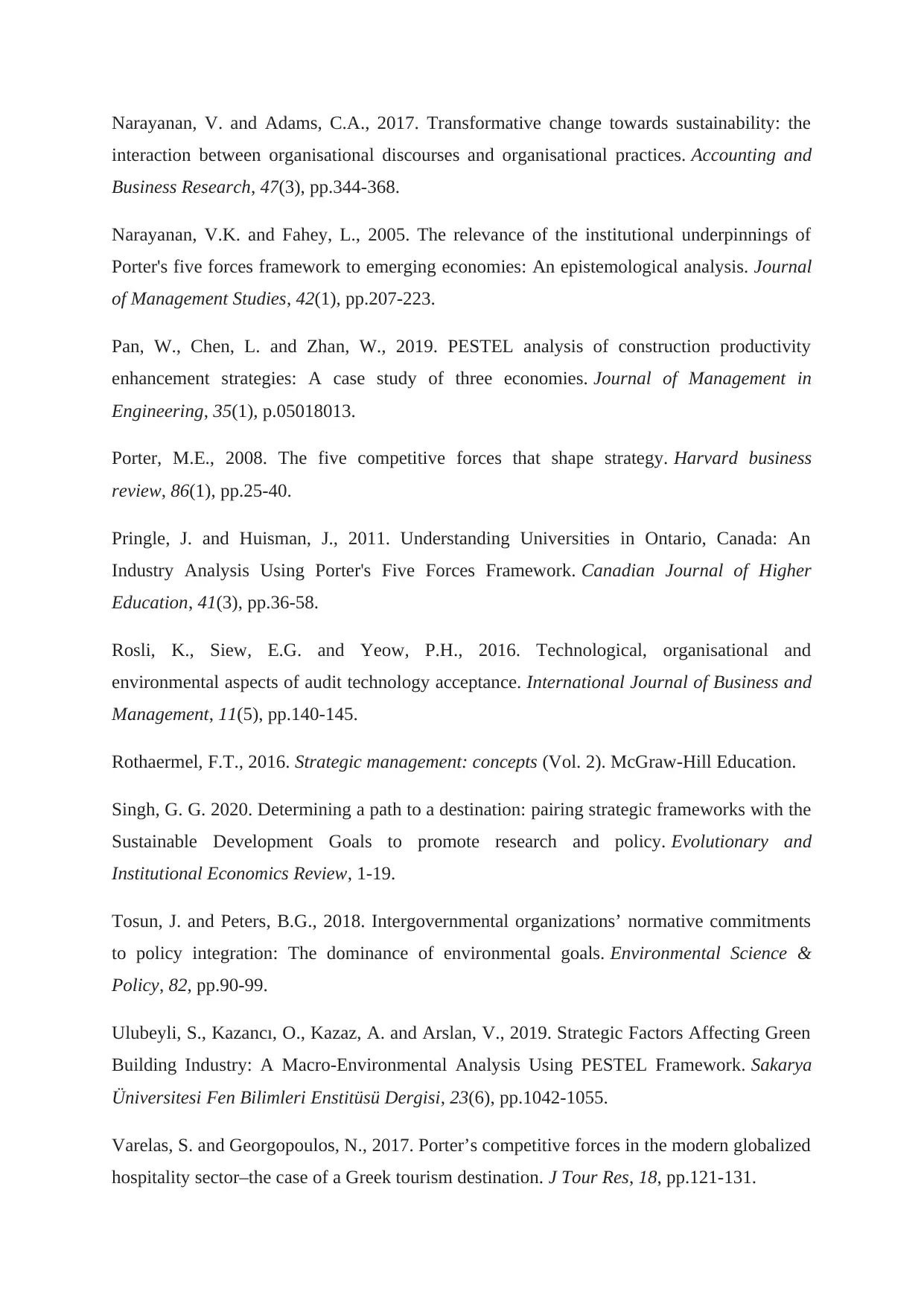
Narayanan, V. and Adams, C.A., 2017. Transformative change towards sustainability: the
interaction between organisational discourses and organisational practices. Accounting and
Business Research, 47(3), pp.344-368.
Narayanan, V.K. and Fahey, L., 2005. The relevance of the institutional underpinnings of
Porter's five forces framework to emerging economies: An epistemological analysis. Journal
of Management Studies, 42(1), pp.207-223.
Pan, W., Chen, L. and Zhan, W., 2019. PESTEL analysis of construction productivity
enhancement strategies: A case study of three economies. Journal of Management in
Engineering, 35(1), p.05018013.
Porter, M.E., 2008. The five competitive forces that shape strategy. Harvard business
review, 86(1), pp.25-40.
Pringle, J. and Huisman, J., 2011. Understanding Universities in Ontario, Canada: An
Industry Analysis Using Porter's Five Forces Framework. Canadian Journal of Higher
Education, 41(3), pp.36-58.
Rosli, K., Siew, E.G. and Yeow, P.H., 2016. Technological, organisational and
environmental aspects of audit technology acceptance. International Journal of Business and
Management, 11(5), pp.140-145.
Rothaermel, F.T., 2016. Strategic management: concepts (Vol. 2). McGraw-Hill Education.
Singh, G. G. 2020. Determining a path to a destination: pairing strategic frameworks with the
Sustainable Development Goals to promote research and policy. Evolutionary and
Institutional Economics Review, 1-19.
Tosun, J. and Peters, B.G., 2018. Intergovernmental organizations’ normative commitments
to policy integration: The dominance of environmental goals. Environmental Science &
Policy, 82, pp.90-99.
Ulubeyli, S., Kazancı, O., Kazaz, A. and Arslan, V., 2019. Strategic Factors Affecting Green
Building Industry: A Macro-Environmental Analysis Using PESTEL Framework. Sakarya
Üniversitesi Fen Bilimleri Enstitüsü Dergisi, 23(6), pp.1042-1055.
Varelas, S. and Georgopoulos, N., 2017. Porter’s competitive forces in the modern globalized
hospitality sector–the case of a Greek tourism destination. J Tour Res, 18, pp.121-131.
interaction between organisational discourses and organisational practices. Accounting and
Business Research, 47(3), pp.344-368.
Narayanan, V.K. and Fahey, L., 2005. The relevance of the institutional underpinnings of
Porter's five forces framework to emerging economies: An epistemological analysis. Journal
of Management Studies, 42(1), pp.207-223.
Pan, W., Chen, L. and Zhan, W., 2019. PESTEL analysis of construction productivity
enhancement strategies: A case study of three economies. Journal of Management in
Engineering, 35(1), p.05018013.
Porter, M.E., 2008. The five competitive forces that shape strategy. Harvard business
review, 86(1), pp.25-40.
Pringle, J. and Huisman, J., 2011. Understanding Universities in Ontario, Canada: An
Industry Analysis Using Porter's Five Forces Framework. Canadian Journal of Higher
Education, 41(3), pp.36-58.
Rosli, K., Siew, E.G. and Yeow, P.H., 2016. Technological, organisational and
environmental aspects of audit technology acceptance. International Journal of Business and
Management, 11(5), pp.140-145.
Rothaermel, F.T., 2016. Strategic management: concepts (Vol. 2). McGraw-Hill Education.
Singh, G. G. 2020. Determining a path to a destination: pairing strategic frameworks with the
Sustainable Development Goals to promote research and policy. Evolutionary and
Institutional Economics Review, 1-19.
Tosun, J. and Peters, B.G., 2018. Intergovernmental organizations’ normative commitments
to policy integration: The dominance of environmental goals. Environmental Science &
Policy, 82, pp.90-99.
Ulubeyli, S., Kazancı, O., Kazaz, A. and Arslan, V., 2019. Strategic Factors Affecting Green
Building Industry: A Macro-Environmental Analysis Using PESTEL Framework. Sakarya
Üniversitesi Fen Bilimleri Enstitüsü Dergisi, 23(6), pp.1042-1055.
Varelas, S. and Georgopoulos, N., 2017. Porter’s competitive forces in the modern globalized
hospitality sector–the case of a Greek tourism destination. J Tour Res, 18, pp.121-131.
Paraphrase This Document
Need a fresh take? Get an instant paraphrase of this document with our AI Paraphraser

Vargas-Hernandez, J.G. and Medrano, M.D.J.M., 2020. The Circular Economy: Analysis
Based on The Theory of Resources and Capabilities. Revista Livre de Sustentabilidade e
Empreendedorismo, 5(2), pp.178-196.
Based on The Theory of Resources and Capabilities. Revista Livre de Sustentabilidade e
Empreendedorismo, 5(2), pp.178-196.
1 out of 11
Related Documents
Your All-in-One AI-Powered Toolkit for Academic Success.
+13062052269
info@desklib.com
Available 24*7 on WhatsApp / Email
![[object Object]](/_next/static/media/star-bottom.7253800d.svg)
Unlock your academic potential
Copyright © 2020–2025 A2Z Services. All Rights Reserved. Developed and managed by ZUCOL.





